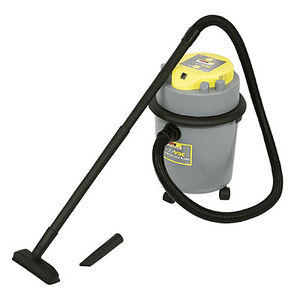Difference between revisions of "Vacuum cleaner"
| Line 101: | Line 101: | ||
Available from [http://www.screwfix.com/app/sfd/cat/pro.jsp?id=23140 Screwfix], Wickes and others. | Available from [http://www.screwfix.com/app/sfd/cat/pro.jsp?id=23140 Screwfix], Wickes and others. | ||
| − | ===Earlex WD1200P | + | ===Earlex WD1200P Power Vac=== |
[http://www.earlex.co.uk/html/wd_html/wd1200p.htm Earlex website] | [http://www.earlex.co.uk/html/wd_html/wd1200p.htm Earlex website] | ||
Revision as of 23:36, 20 May 2007
General Features
Upright, Cylinder or Canister
- 'Cylinder' refers to machines shaped like a cylinder lying horizontally on the ground.
- 'Canister' type machines have a drum-shaped body sitting on its end on the floor (often on wheels).
Both cylinder and canister types suck through a hose which is coupled to appropriate tools for cleaning floors or other purposes.
- Upright, traditional 'Hoover' shaped machines are designed for cleaning floors and have beating brushes and suction at the base. Many uprights nowadays also have hoses for cleaning surfaces other than floors.
Wet and dry
Enables machine to suck up water. Useful for clearing up water spills, especially from carpet where suction can remove more water than mopping could. Also useful for removing small amounts of water from pipework e.g. when swapping over a valve live on low-pressure systems.
Blow and suck
Blow is useful for blowing debris away where suction doesn't work (though obviously messier), blowing water out of pipework, pressurising pipework to detect leaks, and even for inflating garden toys such as large paddling pools.
Power take-off
Mains power socket outlet on the machine for running power tools so that the vacuum switches on when the tool is operated, and switches off (sometimes after a few seconds 'run-on' delay) when the tool is switched off.
Cable retract
Retracting cable makes it easier to carry. No hands are needed for the cable. Looks neat too.
Tool storage
Storage for the machine's hose, rigid tubes, floor tools, nozzles etc is useful (but rarely found).
Machine shop vacuums
Vacuums intended for machine shops have 2 features for high debris volume:
- a 2 bag arrangement where the top bag filters, and the debris then drops into the bottom collection bag.
- wide bore hose, enabling use of longer hose runs
Some also have power take off.
Bag/Filter Types
Traditional domestic machines are mostly designed to catch debris in disposable (single-use) or reusable paper, or reusable cloth bags. 'Dyson' type domestic machines and some others have filters which require cleaning or replacing from time to time.
Cloth Bag
A cloth filter eliminates the cost of bags, and is less likely to clog than paper.
The bag must be emptied, which can be messy.
Performance is middling.
Old cloth filters generally need a thorough clean to restore full suction power.
Paper bag
The bag is disposable, making emptying more or less mess free.
A new paper bag every time means ongoing expense
Paper filters clog very rapidly on building dust.
Cyclone
Cyclones are good for building dust
Some cyclones have additional filters that must be replaced from time to time.
Cyclone vacs with no other filter lose no suction at all due to the filter. In contrast, the back pressure produced by paper & cloth bags is significant, and worsens considerably as the pores clog.
This is partly but not 100% true for cyclones with additional cloth filters, as those filters will give some airflow resistance that increases over time. The presence of the cyclone filter means that much less clogging occurs, but they will still clog eventually.
Dysons have gained a poor reputation for reliability as well as price. Other makes don't generally seem to suffer the same frequent problems.
DIY Cyclone
DIY cyclone filters are easy to make, and can be added to any existing hoover or air filtration system.
http://www.internode.co.uk/cyclone/
http://www.woodcraft.com/articles.aspx?articleid=408
http://codesmiths.com/shed/workshop/techniques/cyclones/
Water
These uncommon vacs use a tub of water to trap the dust.
Presumably the water needs emptying after each use.
Reviews
Earlex WD1000 Combi Vac
PROS:
- cheap
- blows as well as sucks (useful sometimes)
- wet and dry
CONS:
- really needs the wet+dry filter (£10 from Wickes)
- filter needs cleaning: sometimes tapping or brushing off dust will do, from time to time washing and drying it, especially after sucking up lots of fine dust
- mixing wet with fine dust quickly blocks the filter: it is better to empty the canister and remove the filter to sucking up mainly water (flooded floors etc)
- when sucking up lots of water it can spit out (often filthy) water from around the motor housing as well as the blow orifice: workarounds are to station the machine outdoors, or putting a dustsheet over it to catch the spray
- the filter just pushes onto its housing and can slide down, especially if the cleaner is bumped on the floor, resulting in clouds of dust being blown out of the machine
- the filter has a tinplate body which eventually rusts through requiring replacement even if the filter material is still serviceable
- no carrying handle
- tends to tip over if pulled by the hose
- hose just pushes into orifices and can get blown out when fitted to the blow orifice
- short mains cable
- no cable, hose or tool storage
Available from Screwfix, Wickes and others.
Earlex WD1200P Power Vac
As WD1000 (above) but:
PROS:
- power take-out
- handle
- more stable than WD1000
CONS:
- more expensive than WD1000
See also discussion on uk.d-i-y
External Links
- Bill's cyclone dust collection research - DIY cyclonic collectors
- DIY cyclone pictures (click Prev for next picture!)
